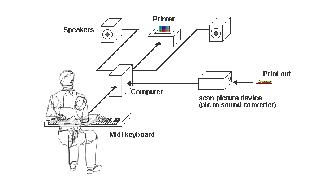Content Description
Above all, the basic notion of this project is that music generates colour pixels on the screen and these pixels are printed on the paper, then this paper can generate music just like storing and playing a CD. In addition, people can compose and record music by marking colour on the paper. In the first processing stage, people play the keyboard to generate colour which creates a visualization and notation of the music. The next stage involves printing colour pixels on the paper. The reason why we made this process is that we wanted the paper to be able to store the music, just like CDs and tapes.
The third part is for scanning colour to regenerate/play the music. We created a box for scanning colour on the paper. It will play what people previously recorded on this music paper, and people can change the instrumentation while playing the music. As I mentioned before, this part of process gives the user the ability to compose and record music with greater ease by filling the empty pixels with colours on the paper. Thus, if people have little knowledge about the process and the difference between colour and music in this project, they will recognize which colour represents which pitch and therefore they can draw their own colour patterns instead of composing notation. Once the composing is done, it plays what you made immediately through a scanning device. People can see how the melody is produced through the colour on the paper before scanning and playing. It can also be a painting tool, which is controlled by music. Users can generate patterns and simple pictures by pitch.


